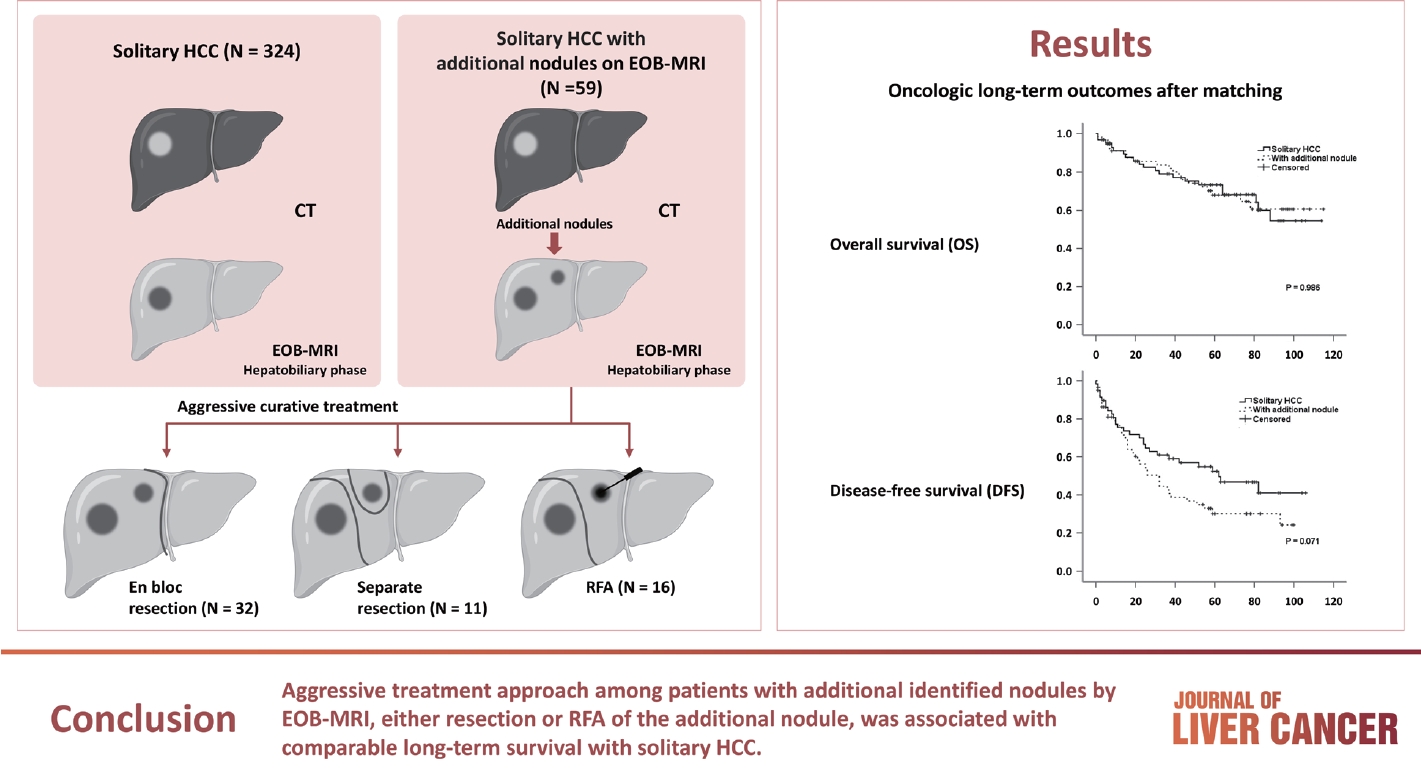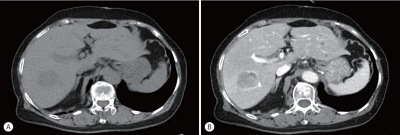- Additional nodules detected using EOB-MRI in patients with resectable single hepatocellular carcinoma: an implication for active treatment strategy
-
Na Reum Kim, Seoung Yoon Rho, Jonathan Navarro, Chansik An, Dai Hoon Han, Jin Sub Choi, Myeong-Jin Kim, Gi Hong Choi
-
J Liver Cancer. 2024;24(1):92-101. Published online February 14, 2024
-
DOI: https://doi.org/10.17998/jlc.2024.01.25
-
-
 Abstract Abstract
 PDF PDF
- Background/Aim
Gadolinium-ethoxybenzyl-diethylenetriamine pentaacetic acid-enhanced magnetic resonance imaging (EOBMRI) further enhances the identification of additional hepatic nodules compared with computed tomography (CT) alone; however, the optimal treatment for such additional nodules remains unclear. We investigated the long-term oncological effect of aggressive treatment strategies for additional lesions identified using EOB-MRI in patients with hepatocellular carcinoma (HCC).
Methods
Data from 522 patients diagnosed with solitary HCC using CT between January 2008 and December 2012 were retrospectively reviewed. Propensity score-matched (PSM) analysis was used to compare the oncologic outcomes between patients with solitary HCC and those with additional nodules on EOB-MRI after aggressive treatment (resection or radiofrequency ablation [RFA]).
Results
Among the 383 patients included, 59 had additional nodules identified using EOB-MRI. Compared with patients with solitary HCC, those with additional nodules on EOB-MRI had elevated total bilirubin, aspartate transaminase, and alanine transaminase; had a lower platelet count, higher MELD score, and highly associated with liver cirrhosis (P<0.05). Regarding long-term outcomes, 59 patients with solitary HCC and those with additional nodules after PSM were compared. Disease-free survival (DFS) and overall survival (OS) were comparable between the two groups (DFS, 60.4 vs. 44.3 months, P=0.071; OS, 82.8 vs. 84.8 months, P=0.986).
Conclusion
The aggressive treatment approach, either resection or RFA, for patients with additional nodules identified on EOBMRI was associated with long-term survival comparable with that for solitary HCC. However, further studies are required to confirm these findings.
- Curative liver transplantation after lung resection for advanced hepatocellular carcinoma with lung metastasis and inferior vena cava tumor thrombosis: a case report
-
Dong Jin Joo, Do Young Kim, Jinsil Seong, Hyun Jeong Kim, Jae Geun Lee, Dai Hoon Han, Gi Hong Choi, Myoung Soo Kim, Jin Sub Choi, Soon Il Kim
-
J Liver Cancer. 2021;21(2):181-186. Published online September 30, 2021
-
DOI: https://doi.org/10.17998/jlc.2021.09.08
-
-
3,640
Views
-
92
Downloads
-
1
Citation
-
 Abstract Abstract
 PDF PDF
- Hepatocellular carcinoma (HCC) with distant metastasis is an absolute contraindication for liver transplantation (LT). However, it is still unclear whether LT is feasible or acceptable in such patients, albeit after being treated with a multidisciplinary approach and after any metastatic lesion is ruled out. We report one such successful treatment with living donor LT (LDLT) after completely controlling far-advanced HCC with inferior vena cava tumor thrombosis and multiple lung metastases. The patient has been doing well without HCC recurrence for eight years since LDLT. The current patient could be an anecdotal case, but provides a case for expanding LDLT indications in the context of advanced HCC and suchlike.
-
Citations
Citations to this article as recorded by  - Inferior Vena Cava Thrombectomy and Stenting as Bridge to Liver Transplantation After Radiotherapy-Induced Thrombosis
Raphael PH Meier, Shani Kamberi, Josue Alvarez-Casas, Barton F. Lane, Chandra S. Bhati, Saad Malik, William Twaddell, Kirti Shetty, Adam Fang, Hyun S. Kim, Daniel G. Maluf
Progress in Transplantation.2023;[Epub] CrossRef
- A Case of Lymphocyte-Rich Hepatocellular Carcinoma in a Patient Who Was Treated for Colon Cancer
-
Jae Won Song, Ho Soo Chun, Jae Seung Lee, Hye Won Lee, Beom Kyung Kim, Seung Up Kim, Jun Yong Park, Sang Hoon Ahn, Young Nyun Park, Dai Hoon Han, Do Young Kim
-
J Liver Cancer. 2021;21(1):69-75. Published online March 31, 2021
-
DOI: https://doi.org/10.17998/jlc.21.1.69
-
-
3,552
Views
-
84
Downloads
-
2
Citations
-
 Abstract Abstract
 PDF PDF
- Hepatocellular carcinoma (HCC) primarily originates in the liver with hepatic differentiation. However, HCCs are not homogenous, and approximately 35% of HCC cases are classified as histopathological variants that present distinct pathologic characteristics. In particular, the lymphocyte-rich variant is the rarest subtype accounting for less than 1% of HCCs, which is not well known to date about molecular features and pathophysiology. Herein, we present a case of a patient who was suspected of metastatic liver cancer and confirmed as lymphocyte-rich HCC pathologically. A 78-year-old woman who underwent a right hemicolectomy for colon cancer was referred to our hospital for a newly detected liver mass. We could not make a decision because of insufficient evidence for diagnosis from imaging studies. After resection, we found that it was a lymphocyte-rich HCC. The pathologic features and prognostic trends of this subtype are also discussed.
-
Citations
Citations to this article as recorded by  - Characterization of lymphocyte‐rich hepatocellular carcinoma and the prognostic role of tertiary lymphoid structures
Bokyung Ahn, Hee‐Sung Ahn, Jinho Shin, Eunsung Jun, Eun‐Young Koh, Yeon‐Mi Ryu, Sang‐Yeob Kim, Chang Ohk Sung, Ju Hyun Shim, JeongYeon Hong, Kyunggon Kim, Hyo Jeong Kang
Liver International.2024; 44(5): 1202. CrossRef - Uncommon variants of hepatocellular carcinoma: Not one size fits all
Reetu Kundu, Nalini Gupta, Debajyoti Chatterjee, Ajay Duseja
Diagnostic Cytopathology.2022; 50(1): 28. CrossRef
|











